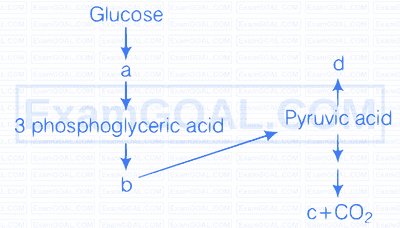Pyruvate is synthesised in cytoplasm of the cell by the process of glycolysis. 1 molecule of glucose forms 2 molecules of pyruvate through a series of reactions. Pyruvic acid dehydrogenase catalyses the reaction in which pyruvate forms acetyl $\mathrm{Co}-\mathrm{A}$. It requires $\mathrm{NAD}^{+}$, Co-enzyme A and $\mathrm{Mg}^{2+}$ ions for its activity. The reaction is as follows
$$\text { Pyruvic acid }+\mathrm{Co}-\mathrm{A}+\mathrm{NAD}^{+} \xrightarrow[\text { Pyruvate Dehydrogenase }]{\mathrm{Mg}^{2+}} \text { Acetyl } \mathrm{Co}-\mathrm{A}+\mathrm{NADH}+\mathrm{H}^{+}+\mathrm{CO}_2 \uparrow$$
Living cells obtain energy through respiration. It is the process of generating energy in the form of ATP molecules by breaking down food molecules like glucose, fats, etc. The process starts with glycolysis which occurs in cytoplasm producing pyruvic acid. It is then converted to acetyl Co-A, which enters mitochondrial matrix. This initiates the tricarboxylic acid cycle.

This cycle is said to be amphibolic because many intermediate compounds formed in this cycle act as precursors for biosynthesis of many important biological molecules, i.e., co-enzymes, vitamins, hormones. Besides this, many molecules, i.e., fatty acids, aminoacids, co-enzymes etc, can enter this cycle directly.
Acetyl Co-A is related to synthesis and breakdown of fatty acids, steroids, carotenoids terpenes and aromatic compounds. $\alpha$-ketoglutarate and oxaloacetate are row materials for synthesis of amino acids like glutamate and aspartate and also pyrimidines and alkaloids. Succinyl forms pyrroole compunds like cytochrome and chlorophyll.
So, it is the cycle where both breakdown and synthesis reactions keep on going simultaneously. the following figure shows interrelationship among netabolic pathway showing respiration mediated break down of different organic molecule.
Krebs' cycle occurs in the matrix of mitochondria. It is depicted in the following series of reactions

Electron transport chain is carried out in the inner mitochondria membrane The inner mitochondrial membrane is specific about possessing proton $\left(\mathrm{H}^{+}\right)$and electron $\left(e^{-}\right)$acceptors in a particular sequence called electron transport chain. It has four enzyme complexes.
The electrons either follow the pathway of complexes I, III and IV or II, III and IV depending upon the substrates from Krebs' cycle.
The transfer of electrons and hydrogen atoms takes place in the following way Complex I Consists of flavoproteins of NADH dehydrogenase (FP ${ }_{\mathrm{N}}$ ) of which FMN is the prosthetic group. Combined with the flavoprotein is non-heme iron of NADH dehydrogenase. This complex spans inner mitochondrial membrane and is able to translocate protons across it from matrix side to outer side.
Complex II Consists of flavoprotein of succinate dehydrogenase, of which FAD is the prosthetic group. Combined with the flavoprotein is non-heme iron of succinate dehydrogenase.
Between complexes II and III is the mobile carrier coenzyme-Q (Co-Q) or ubiquinone (UQ). Complex III Consists of cytochrome-b and cytochrome- $c_1$. Associated with cytochrome- b is non-heme iron of complex III. Between complexes III and IV is the mobile carrier cytochrome-c.
Complex IV Consists of cytochrome-a and cytochrome- $a_3$, and bound copper that are required for this complex reaction to occur. This cytochrome also called cytochrome oxidase, is the only electron carrier in which the heme iron has a free ligand that can react directly with molecular oxygen.

Thus, hydride ions are transferred from the substance to be oxidised to NAD ${ }^{+}$. From NAD ${ }^{+}$ the hydrogen atoms are transferred to FMN of flavoprotein 1 (Fp'N). After FMN the hydrogen atom undergoes ionisation, i.e., it splits into an electron and a proton.
In further stages there is no longer a transfer of hydrogens but of electrons. The electron passes to co-enzyme- Q , and from co-enzyme Q to cytochromes- $b, c_1, c, a$ and $a_3$. The proton is released free.
As the hydrogen atom or electron passes down by $\mathrm{F}_0-\mathrm{F}_1$ particle the chain, there is simultaneous oxidation of one coenzyme and reduction at another steps. Oxygen is able to diffuse indside the mitochondria.
It is converted to anionic form $\mathrm{O}_2^{-}$, combines with $2 \mathrm{H}^{+}$and forms metabolic water reduced co-enzyme NADH $+\mathrm{H}^{+}$helps in pushing out three pairs of $\mathrm{H}^{+}$to outer chamber while FADH ${ }_2$ sends two pairs of $\mathrm{H}^{+}$to outer chamber.
Oxidative phosphorylation is the synthesis of energy rich ATP molecules, with the help of energy liberated during oxidation of reduced co-enzyme ( $\mathrm{NADH}_2, \mathrm{FADH}_2$ ) produced in respiration. The enzyme required for this synthesis is called ATP synthase present in inner mitochondria membrane.
The following figures shows this process

In the following flow chart, replace the symbols $\mathrm{a}, \mathrm{b}, \mathrm{c}$ and d with appropriate terms. Briefly explain the process and give any two application of it.

The metabolic pathway given in the figure is fermentation. The products marked as $a, b, c$ and $d$ represents
a-Glyceraldehyde 3 phosphate,
b-Phosphoenol pyruvic acid,
c-Ethanol,
d-Lactic acid

The fermentation is of two types
(i) Alcohol Fermentation in Yeast Fermentation is an incomplete oxidation of glucose under anaerobic condition. Alcohol fermentation in yeast occurs in 2 sets of reaction thus, converting pyruvic acid into ethanol and $\mathrm{CO}_2$.
A. In the first step, pyruvic acid is decarboxylated (equation I), resulting in the formation of acetaldehyde and $\mathrm{CO}_2$.
$$\mathop {2C{H_3}COCOOH}\limits_{Pyruvic\,acid} \buildrel {Pyruvic\,decarboxylase} \over \longrightarrow \mathop {2C{H_3}CHO}\limits_{Acetaldehyde} $$ ..... (i)
B. In the second step acetaldehyde is reduced to alcohol by $\mathrm{NADH}_2$ (equation (ii))

(ii) Lactic Acid Fermentation in Muscles
In animal tissue like muscles, during exercise, when oxygen is inadequate for cellular respiration pyruvic acid is reduced to lactic acid by lactate dehydrogenase. The reducing agent is $\mathrm{NADH}+\mathrm{H}^{+}$which is reoxidised to $\mathrm{NAD}^{+}$in the subsequent processes.
Two applications of fermentation process are
(i) It helps in manufacture of ethyl alcohol.
(ii) It also helps in curdling of milk to make curd aided by bacteria Lactobacillus.

Given below is a diagram showing ATP synthesis during aerobic respiration, replace the symbols A , $B, C, D$ and $E$ by appropriate terms as given below. F 1 , particle, formation of $\mathrm{Pi}, 2 \mathrm{H}^{+}$, inner mitochondrial membrane, ATP, Fo particle, ADP.
Symbol A, B, C, D and E in the diagram represents
A - ATP
$B-F_1$ particle
$\mathrm{C}-\mathrm{Pi}$
$\mathrm{D}-2 \mathrm{H}^{+}$ E - inner mitochondria membrane.